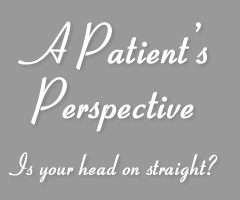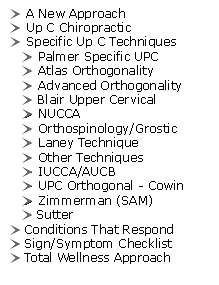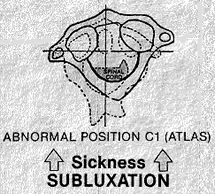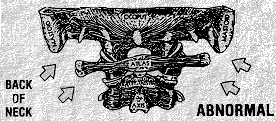

 |
 |
|
Home | A New Approach | Specific Up C Techniques | Kale Brainstem KALE UPPER CERVICAL
The
KALE UpC X-ray Analysis In the Kale upper cervical X-ray analysis 3 X-ray views are used to determine the patient’s listing (subluxated atlas position): These X-ray views are the AP open mouth, the lateral cervical spine (central ray through C1) and the base posterior. The X-rays are not used as a definitive guide to existence of a subluxation, thus Kale incorporated scanning using thermal scanning equipment. If the apparent listing does not clear the scan, then the listing will be re-evaluated and changed until the end result is a clear pattern on the scan. Kale did not teach palpation as a reliable source of information due to his opinion as to the subjectivity of palpation.
These figures again show the ‘phenomenon’, which IS the atlas subluxation. Think about the weight of a person’s head and imagine the job that the ligaments supporting it have to perform. It’s not hard to visualize what can happen to the skull to atlas to axis relationship when someone sustains a bump or knock to the head and/or neck. The KALE ADJUSTMENT After a rest period of at least 15 to 20 minutes, the patient is rechecked to see if the pattern has not returned thus confirming that the subluxation is removed. Kale never really emphasised leg length as a pointer to subluxation so he would rely on the scanning instrumentation to determine if subluxation remained. There can also be leg length discrepancies as a result of anatomic variations, and thus relying on leg length analysis requires understanding of this factor. From the Kale website I acquired the following statistics. I have no way of verifying these numbers, however I place them here for reference. Apparently, the statistics used in this chart are based upon the ‘Committee on Research of the International Chiropractors Association, the Kale Network and Kale Research Centre’. These findings represent the results obtained with specific chiropractic ("Brain Stem Procedure") care for a wide range of chronic conditions. The majority of these cases had also been previously diagnosed and treated by practitioners other than chiropractors. Having researched upper cervical chiropractic for years, the results in the table do not surprise me and emphasise the importance of Governments around the World putting far more priority and funds into chiropractic research. Research is far too heavily weighted towards drug research or research which involves surgical procedures. Specific upper cervical chiropractic, and the gentle adjustment techniques used today involve no invasive procedures. Seems to me that for the sake of sick people, chiropractic should be given a chance. The human body is quote capable of looking after itself given the right conditions. Comment: look at the “% well or much improved” column for so-called hearing disorders; deafness, dizziness, Meniere’s disease and vertigo. The correlation between hearing disorders and dysfunction of the upper cervical spine is well known in upper cervical chiropractic. TABLE from http://kale.com/kaleweb/chiropractic/results.htm
|


